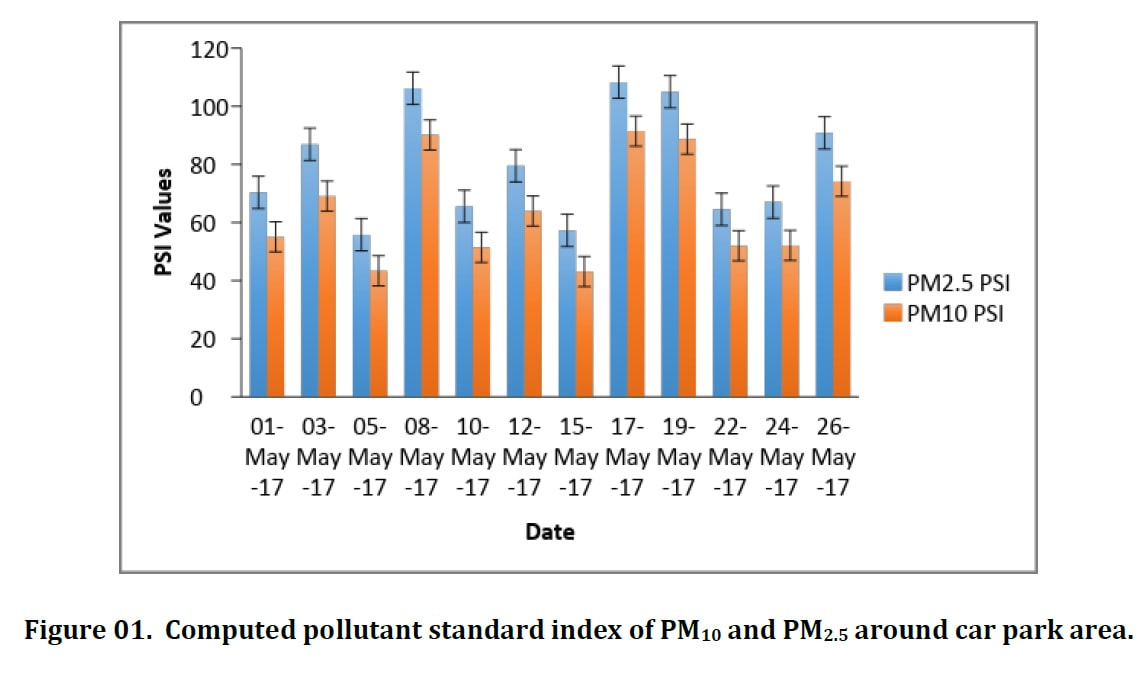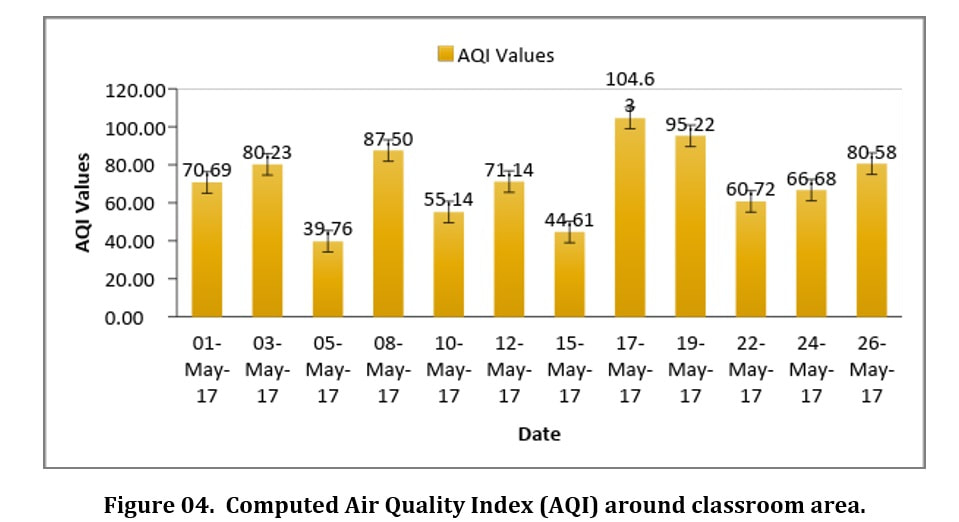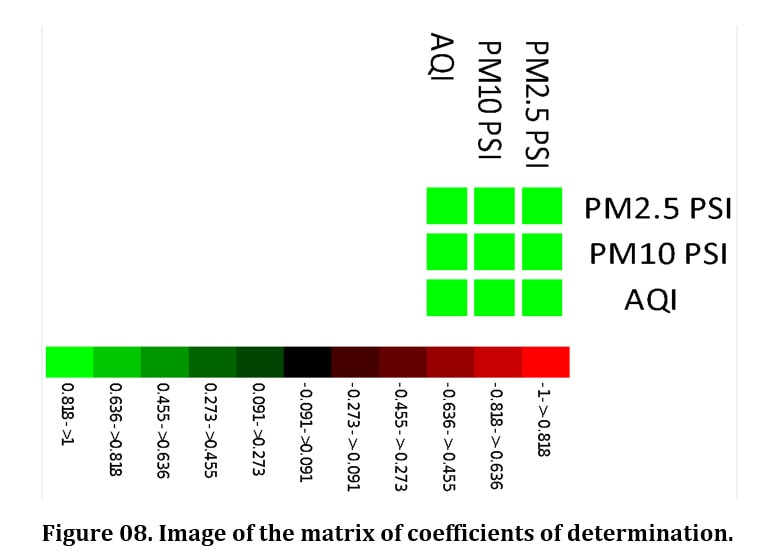J. Sci. Technol. Environ. Inform. | Volume 07, Issue 02, 517-532| https://doi.org/10.18801/jstei.070219.54
Article type: Research article, Received: 17.02.2019, Revised: 26.03.2019, Date of Publication: 25 April 2019.
Article type: Research article, Received: 17.02.2019, Revised: 26.03.2019, Date of Publication: 25 April 2019.
Evaluation of daily pollutant standard index and air quality index in a university campus in Nigeria using PM10 and PM2.5 particulate matter
Osimobi, O. J. 1, Yorkor, B. 2 and Nwankwo, C. A. 3
1Environmental Sustainable Energy Engineering, Royal Melbourne Institute of Technology (RMIT), Melbourne, Australia.
2School of Basic Studies, University of Port Harcourt, Nigeria.
3Dept. of Civil and Environmental Engineering, University of Port Harcourt, Nigeria.
1Environmental Sustainable Energy Engineering, Royal Melbourne Institute of Technology (RMIT), Melbourne, Australia.
2School of Basic Studies, University of Port Harcourt, Nigeria.
3Dept. of Civil and Environmental Engineering, University of Port Harcourt, Nigeria.
Abstract
A study on the evaluation of pollutant standard index and air quality index in Choba campus of the University of Port Harcourt, Nigeria based on particulate matter were assessed. Aeroqual-PM10/PM2.5 and CW-HAT200 particulate sampler instruments that measure particulate matter by a method of light scattering were used. Pollutant standard index and air quality index were computed using measure concentrations of PM10 and PM2.5 particulate matter. The study shows that a positive linear relationship exists between pollutant standard index and air quality index, the relationship is highly significant (p-values < 0.0001, R2 = 99.1 %). Statistical result indicates that PM2.5 constitutes 52.68% of the concentrations of PM10. PM2.5 fine particle was found to be the predominant particulate pollutant in the University Campus. Computed air quality index shows good air quality 17% of the days, moderate air quality 79% of the days and unhealthy air quality for sensitive groups 4% of the days. Sensitive groups on the campus may be experiencing coughing, shortness of breath sneezing, asthma attacks, coughing, reduced lung function and wheezing. The management of the university should communicate the air quality indices in this study to the students and public so that precautionary measures can be taken to reduce prolong exposure.
Key Words
Air pollution, Exceedance factors, Pollutants standard, sensitive groups and Health hazards.
A study on the evaluation of pollutant standard index and air quality index in Choba campus of the University of Port Harcourt, Nigeria based on particulate matter were assessed. Aeroqual-PM10/PM2.5 and CW-HAT200 particulate sampler instruments that measure particulate matter by a method of light scattering were used. Pollutant standard index and air quality index were computed using measure concentrations of PM10 and PM2.5 particulate matter. The study shows that a positive linear relationship exists between pollutant standard index and air quality index, the relationship is highly significant (p-values < 0.0001, R2 = 99.1 %). Statistical result indicates that PM2.5 constitutes 52.68% of the concentrations of PM10. PM2.5 fine particle was found to be the predominant particulate pollutant in the University Campus. Computed air quality index shows good air quality 17% of the days, moderate air quality 79% of the days and unhealthy air quality for sensitive groups 4% of the days. Sensitive groups on the campus may be experiencing coughing, shortness of breath sneezing, asthma attacks, coughing, reduced lung function and wheezing. The management of the university should communicate the air quality indices in this study to the students and public so that precautionary measures can be taken to reduce prolong exposure.
Key Words
Air pollution, Exceedance factors, Pollutants standard, sensitive groups and Health hazards.
Article Full-Text PDF
| 54.02.07.19_evaluation_of_daily_pollutant_standard_index_and_air_quality_index_in_a_university_campus_in_nigeria.pdf | |
| File Size: | 1227 kb |
| File Type: | |
|
Share This Article
|
|
Article Citations
MLA
Osimobi, O. J. et al.“ Evaluation of daily pollutant standard index and air quality index in a university campus in Nigeria using pm10 and pm2.5 particulate matter.” Journal of Science, Technology and Environment Informatics 07(02) (2019): 517-532.
APA
Osimobi, O. J., Yorkor, B. and Nwankwo, C. A. (2019). Evaluation of daily pollutant standard index and air quality index in a university campus in Nigeria using pm10 and pm2.5 particulate matter. Journal of Science, Technology and Environment Informatics, 07(02), 517-532.
Chicago
Osimobi, O. J., Yorkor, B. and Nwankwo, C. A.“ Evaluation of daily pollutant standard index and air quality index in a university campus in Nigeria using pm10 and pm2.5 particulate matter.” Journal of Science, Technology and Environment Informatics 07(02) (2019): 517-532.
Harvard
Osimobi, O. J., Yorkor, B. and Nwankwo, C. A. 2019. Evaluation of daily pollutant standard index and air quality index in a university campus in Nigeria using pm10 and pm2.5 particulate matter. Journal of Science, Technology and Environment Informatics, 07(02), pp. 517-532.
Vancouver
Osimobi, OJ, Yorkor, B and Nwankwo, CA. Evaluation of daily pollutant standard index and air quality index in a university campus in Nigeria using pm10 and pm2.5 particulate matter. Journal of Science, Technology and Environment Informatics. 2019 April 07(02): 517-532.
Osimobi, O. J. et al.“ Evaluation of daily pollutant standard index and air quality index in a university campus in Nigeria using pm10 and pm2.5 particulate matter.” Journal of Science, Technology and Environment Informatics 07(02) (2019): 517-532.
APA
Osimobi, O. J., Yorkor, B. and Nwankwo, C. A. (2019). Evaluation of daily pollutant standard index and air quality index in a university campus in Nigeria using pm10 and pm2.5 particulate matter. Journal of Science, Technology and Environment Informatics, 07(02), 517-532.
Chicago
Osimobi, O. J., Yorkor, B. and Nwankwo, C. A.“ Evaluation of daily pollutant standard index and air quality index in a university campus in Nigeria using pm10 and pm2.5 particulate matter.” Journal of Science, Technology and Environment Informatics 07(02) (2019): 517-532.
Harvard
Osimobi, O. J., Yorkor, B. and Nwankwo, C. A. 2019. Evaluation of daily pollutant standard index and air quality index in a university campus in Nigeria using pm10 and pm2.5 particulate matter. Journal of Science, Technology and Environment Informatics, 07(02), pp. 517-532.
Vancouver
Osimobi, OJ, Yorkor, B and Nwankwo, CA. Evaluation of daily pollutant standard index and air quality index in a university campus in Nigeria using pm10 and pm2.5 particulate matter. Journal of Science, Technology and Environment Informatics. 2019 April 07(02): 517-532.
References
- Abali, H. W., Etebu, O. M. and Leton, T. G. (2018). Seasonal particulate pollution in port Harcourt Nigeria. J. Environ. Pollu. Hum. Health, 6, 20-25.
- Addinsoft (2019). XLSTAT statistical and data analysis solution. Boston, USA. Retrieved from https://www.xlstat.com.
- Aeroqual Ltd. (2017). Technical Note: Particulate Matter Sensor Head PM10 / PM2.5 (PM). Retrieved from www.aeroqual.com.
- Air Quality Communication Workshop (2012). Air Quality Index (AQI). San Salvador, El Salvador.
- Akinfolarin, O. M., Boisa, N. and Obunwo, C. C. (2017). Assessment of particulate matter-based air quality index in port Harcourt Nigeria. J. Environ. Anal. Chem. 4, 224. https://doi.org/10.4172/2380-2391.1000224
- Carslaw, D. C. and Ropkins, K. (2012). Open air-an R package for air quality data analysis. Environmental Modeling and Software. Volume 27-28, pp. 52–61. https://doi.org/10.1016/j.envsoft.2011.09.008
- Federal Register (1998). Proposed Rule. Vol. 63, No. 236. Retrieved 14 February 2019 from https://www3.epa.gov/ttn/amtic/archive/files/ambient/other/psi/fr-aqir.pdf.
- Garg, S. K., Garg, R. and Garg, R. (2006). Environmental science and ecological studies Delhi. Khanna Publishers Hyderabad, India.
- Illinois Environmental Protection Agency (2013). Illinois Annual Air Quality Report 2012, Section 3: Air Quality Index.
- Ityavyar, E. M. and Thomas, T. T. (2012). Environmental pollution in Nigeria: the need for awareness creation for sustainable development. Journal of research in forestry, wildlife and environment. Volume 4, no. 2.
- Janssen, N. A. H., Gerlofs-Nijland, M. E., Lanki, T., Salonen, R. O., Cassee, F., Hoek, G., Fischer, P., Brunekreef, B. and Krzyzanowski, M. (2012). Health effects of black carbon. Copenhagen, WHO Regional Office for Europe. Retrieved from http://www.euro.who.int/en/what-we-do/health-topics/environmentand-health/air-quality/publications/2012/health-effects-of-black-carbon.
- Krzyzanowski, M. and Gapp, C. (2011). Exposure to air pollution (particulate matter) in outdoor air. WHO European Centre for Environment and Health, Bonn, Germany. Retrieved 14 February 2019 from www.euro.who.int/ENHIS.
- M and A Instruments Inc. (2018). Handheld portable particle counter PM2.5 PM10 unit Microgram/Cubic Meter. Retrieved from https://www.amazon.com/Handheld-Portable-Particle-Counter-Microgram/dp/B00IPCB0L8.
- Mohapatra, K. and Biswal, S. K., (2014). Effect of particulate matter (pm) on plants, climate, ecosystem and human health. International Journal of Advanced Technology in Engineering and Science, Volume No. 02, pp. 118-129.
- Osimobi, O. J. and Nwankwo, C. A. (2018). Assessment of particulate matter concentrations in a university campus in Nigeria. J. Environ Stud. 4(1), pp. 1- 4. https://doi.org/10.13188/2471-4879.1000024
- Rao, M. N. and Rao, H. V. N. (2005). Air pollution. Tata McGraw-Hill Publishing Company Limited, New Delhi.
- Rather, P. A., Mushtaq, B., Wanganeo, A., Bhat, B. A. and Wani, M. A. (2014). Air quality of university campus and national highway no. 12 at Hoshangabad Road, Bhopal, India. Int. J. Marine Atmos. Earth Sci. 2, 52-57.
- USDHHS (2017). Oak Creek power plant: analysis of ambient particulate matter data. Letter Health Consultation, U.S. Department of Health and Human Services. Agency for Toxic Substances and Disease Registry
- USEPA (2003). Air Quality Index: A Guide to Air Quality and Your Health. Retrieved from Air and Radiation EPA-454/K-03-002 http://www.epa.gov/.
- USEPA (2016a). US Environmental protection agency. 2016. Air Quality Index (AQI) Basics. Retrieved 31 August 2019 from https://www.airnow.gov/index.cfm?action=aqibasics.aqi.
- USEPA (2016b). Air quality guide for particle pollution. Retrieved 26 January 2019 from https://www.airnow.gov/index.cfm?action=pubs.aqguidepart.
- WHO, (2006). WHO air quality guidelines for particulate matter, ozone, nitrogen dioxide and sulfur dioxide. Global update 2005, Summary of risk assessment. WHO/SDE/PHE/OEH/06.02.
- WHO (2013). Health effects of particulate matter: Policy implications for countries in Eastern Europe, Caucasus and central Asia. WHO Regional Office for Europe, UN City, Marmorvej 51, DK-2100 Copenhagen Ø, Denmark. Retrieved from http://www.euro.who.int/pubrequest.
- Yakubu, O. H. (2017). Particle (soot) pollution in Port Harcourt Rivers State, Nigeria-double air pollution burden? Understanding and tackling potential environmental public health impacts. Environments 5, 2. https://doi.org/10.3390/environments5010002
© 2019 The Authors. This article is freely available for anyone to read, share, download, print, permitted for unrestricted use and build upon, provided that the original author(s) and publisher are given due credit. All Published articles are distributed under the Creative Commons Attribution 4.0 International License.
Journal of Science, Technology and Environment Informatics, EISSN 2409-7632.


